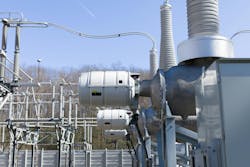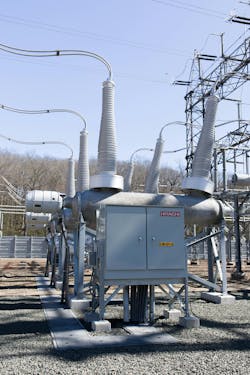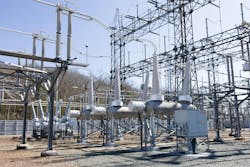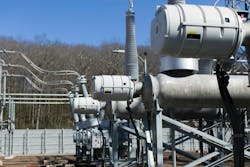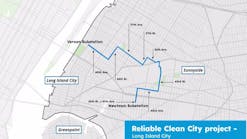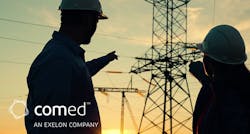In the middle of December 2023, at a substation in central Connecticut, a small group bundled in warm clothes braved the freezing temperature and biting cold wind to witness a historic moment: the commissioning of the world’s first transmission-level SF6-free dead tank circuit breaker.
However, when the breaker was energized, the scene was devoid of fanfare. True to its character, electricity coursed invisibly and silently through wire. Yet, this seemingly quiet event marked a departure from energy paradigms of the past and forever changed the transmission and distribution landscape. It also was the climax of a collaboration project between Hitachi Energy Ltd. and Eversource Energy that began 18 months before.
Prior to the 1970s, oil was the primary insulation medium in high-voltage circuit breakers, even if that came with several drawbacks: circuit breakers were bulky, required frequent maintenance and posed environmental risks due to potential fires. Since the 1960s, utilities began replacing oil circuit breakers with other breaker technologies, such as air blast breakers. However, it was the introduction of SF6 technology in the 1970s that offered a significant leap forward for the utility industry.
SF6 boasts several key advantages, such as a remarkable dielectric withstand voltage that allows for the construction of significantly smaller breakers compared to former alternatives and superior arc-quenching properties. The latter enables efficient cooling of the electrical arc during contact separation, leading to high fault current handling capabilities. However, while SF6 offers operational benefits, it comes with a substantial environmental cost. It has a very high global warming potential, meaning it traps heat in the atmosphere far more effectively than any other known industrial gases. While the gas is contained within a pressurized compartment, losses occur during production, throughout the equipment’s 40-plus-year lifespan and during breaker disposal.
Given the continuous growth of the high-voltage switchgear market, driven by renewable energy integration and increasing global electricity demand, the SF6 stored in these breakers poses a significant climate challenge. Consequently, finding effective alternatives for insulation gas is paramount to switchgear manufacturers.
An Alternative Solution
Replacing SF6 is no simple task. Utilities as well as distribution and transmission system operators (DSOs and TSOs) are cautious when it comes to implementing new technologies. This is with good reason, as grid stability and availability are of the utmost importance. The new gas must match the original design’s critical parameters without significantly compromising electrical performance, reliability, lifetime, maintainability and size.
New England’s largest utility, Eversource delivers safe and reliable energy to approximately 4.4 million customers across Connecticut, Massachusetts and New Hampshire. In addition to water and natural gas, its electric service territory encompasses 500 towns and over 13,000 sq miles (33,670 sq km) across all three states. To better serve the communities where it operates, Eversource has set an industry-leading goal to be carbon neutral by 2030, which would make it the first investor-owned utility in the nation to be carbon neutral.
The utility plans to achieve this aggressive goal through corporate operations, gas distribution and electric T&D. One major focus is to enhance the electric T&D system to reduce line losses and reduce reliance on SF6 in gas-insulated electric switchgear. Eversource has made progress in reducing SF6 emissions since 2019, through improved equipment maintenance and tracking, but it recognized more work needed to be done.
Eversource embarked on a collaborative journey with one of its strategic partners in the industry, Hitachi Energy, to pilot an SF6-free solution. At the forefront of the energy transition, Hitachi Energy already had launched the EconiQ high-voltage portfolio, which promised to deliver reliability and exceptional environmental performance without using any SF6 or presenting any of its drawbacks.
The EconiQ portfolio is an alternative solution for high-voltage equipment such as gas-insulated switchgear (GIS), gas-insulated lines (GIL), dead tank breakers (DTBs) and hybrid switchgear. New equipment is being designed and built in a similar manner and on a similar platform to its SF6 equivalent, allowing for easier retrofit or replacement of existing assets. Equipment is fully type-tested to meet International Electrotechnical Commission (IEC) and Institute of Electrical and Electronics Engineers (IEEE) standards and specifications.
The First Installation
In August 2022, Hitachi Energy and Eversource formally announced the collaboration to install the first 420-kV EconiQ circuit breaker. This announcement set the stage for both companies to take a major step toward their carbon footprint reduction and sustainability goals. It also set the wheels in motion for an aggressive schedule in which engineering, design, manufacturing, factory acceptance, delivery, construction, installation, training and equipment commissioning would occur in less than 18 months.
For this project, the first endeavor was to reduce SF6 emissions in the 362-kV breakers, which held a significant proportion of SF6 within Eversource’s transmission system — approximately 52% of the installed SF6 volume across all operating regions. With age-based obsolescence and end of life for most of its fleet still 15 years to 20 years away, an aging population represented a significant risk in achieving Eversource’s carbon neutrality goals.
As such, the strategy considered brownfield and greenfield applications as two distinct needs. As new design and construction could accommodate potential differences due to SF6-free technology, greenfield applications were considered more flexible and, thus, a lower risk and lower overall priority in the SF6 emission reduction plan.
With specific project needs in focus, Hitachi Energy developed an alternative DTB technology to minimize the environmental impact of the power grid. Scalability and reliability were ensured by developing a solution applicable across different voltage levels for faster and broader adoption. The aim was to accelerate the transition by enabling a swift shift toward SF6-free technology while acknowledging the long lifespan of existing breakers: SF6 breakers installed today will still be in service beyond 2050.
Possessing a similar footprint and appearance to conventional DTB equipment, it is hard to immediately identify an SF6-free breaker like the one installed in Eversource’s substation. The processes for installation, testing, maintenance and operation are like those for a conventional SF6 DTB. The main difference lies in the steps taken in gas handling and filling. Hitachi Energy’s service team worked in tandem with Eversource personnel to install and commission the first 362-kV SF6-free DTB.
The equipment was successfully installed between October 2023 and December 2023. Pre-construction and construction activities to ensure the site was prepared for the new circuit breaker included removal of the old circuit breaker, demolition of the existing foundation, installation of a new cable raceway, pouring of the new foundation, pulling and poising of new interface cabling and supplementary supervisory control and data acquisition (SCADA) upgrades.
Functional testing and final commissioning of the circuit breaker took place over 11 days, culminating with the successful energization of the circuit breaker on Dec. 20, 2023. However, gas handling, sampling and analysis needed to be completed before any testing could be performed. The final commissioning of the EconiQ circuit breaker was very similar to its 362-kV SF6 counterpart. Considering the equipment was built on a similar platform, all testing was performed on time due to Eversource’s field test team’s familiarity with commissioning and maintaining this type of equipment.
Real-World Performance
In retrospect, alternative SF6-free equipment looks like the most obvious solution, but at the time Eversource entered into the pilot project, there were no commercially available industry solutions that met both system operating voltage and fault duty specifications. Beyond the availability of the needed solution, unknown factors associated with SF6-free technology — such as the size, weight, safety restrictions, operational limitations, monitoring and alarming — left many questions unanswered regarding the feasibility of designing and applying this new technology and its impact on substation design standards and operational practices.
Being the first installation in the world, every step was minutely studied and discussed in advance. Hitachi Energy met Eversource’s outage schedule and also maintained the complex overall project schedule, thus ensuring a smooth site execution and successful project completion. The project would be challenging in any circumstances, but even more so in this instance as it was a global pilot that included ongoing type-test certification.
This collaboration served a dual purpose. It allowed both parties to gather valuable insights into the real-world performance of the new SF6-free technology and will enable Eversource to achieve its ambitious carbon neutrality target by 2030.
The initial energization of the SF6-free DTB captured the magic of the first time that light flooded a room with the flick of a switch. In the annals of the adventures of electricity, SF6-free DTB is a milestone in the journey toward a more sustainable power grid. This project is the culmination of years of research, development and collaboration. It paves the way for a future where clean energy transmission goes hand in hand with environmental stewardship. Now more than ever, advancements such as this are needed to forge ahead toward a sustainable energy future and support utilities to transition to cleaner technologies.

